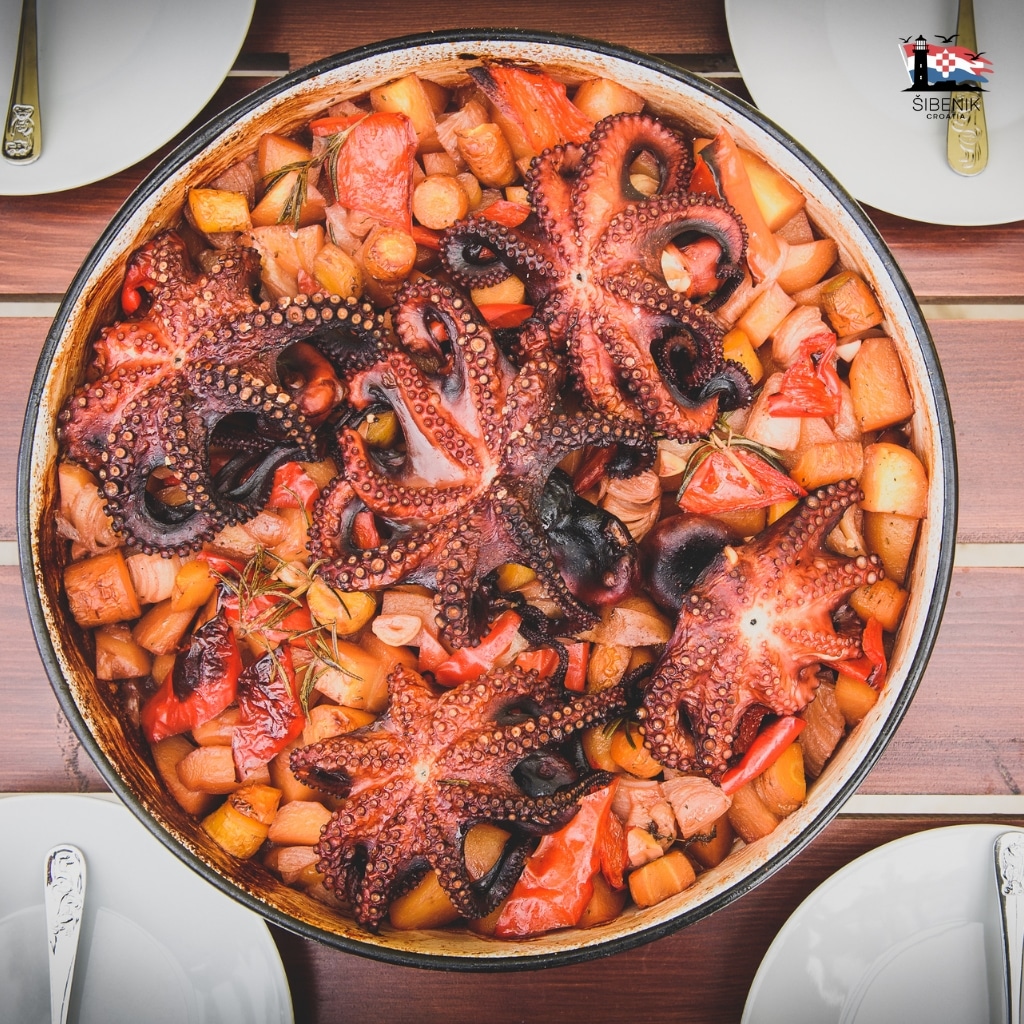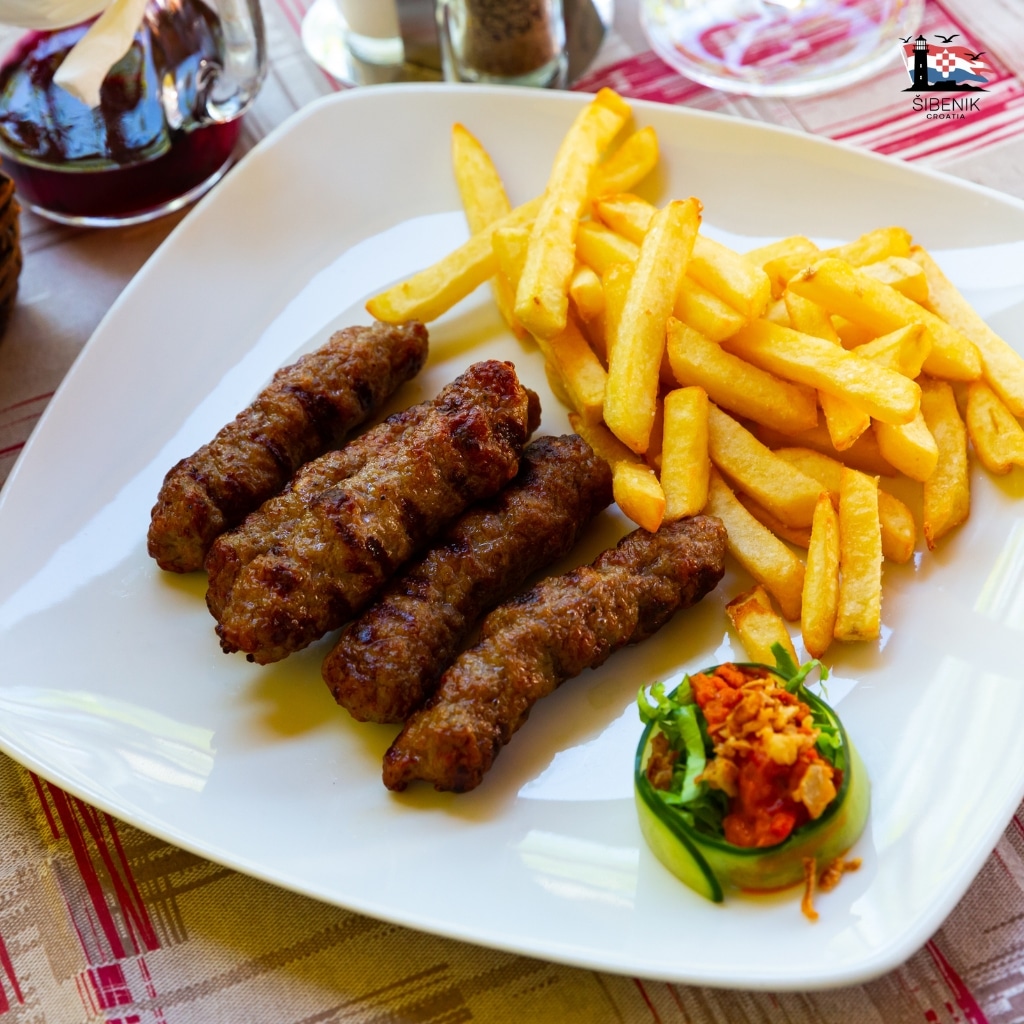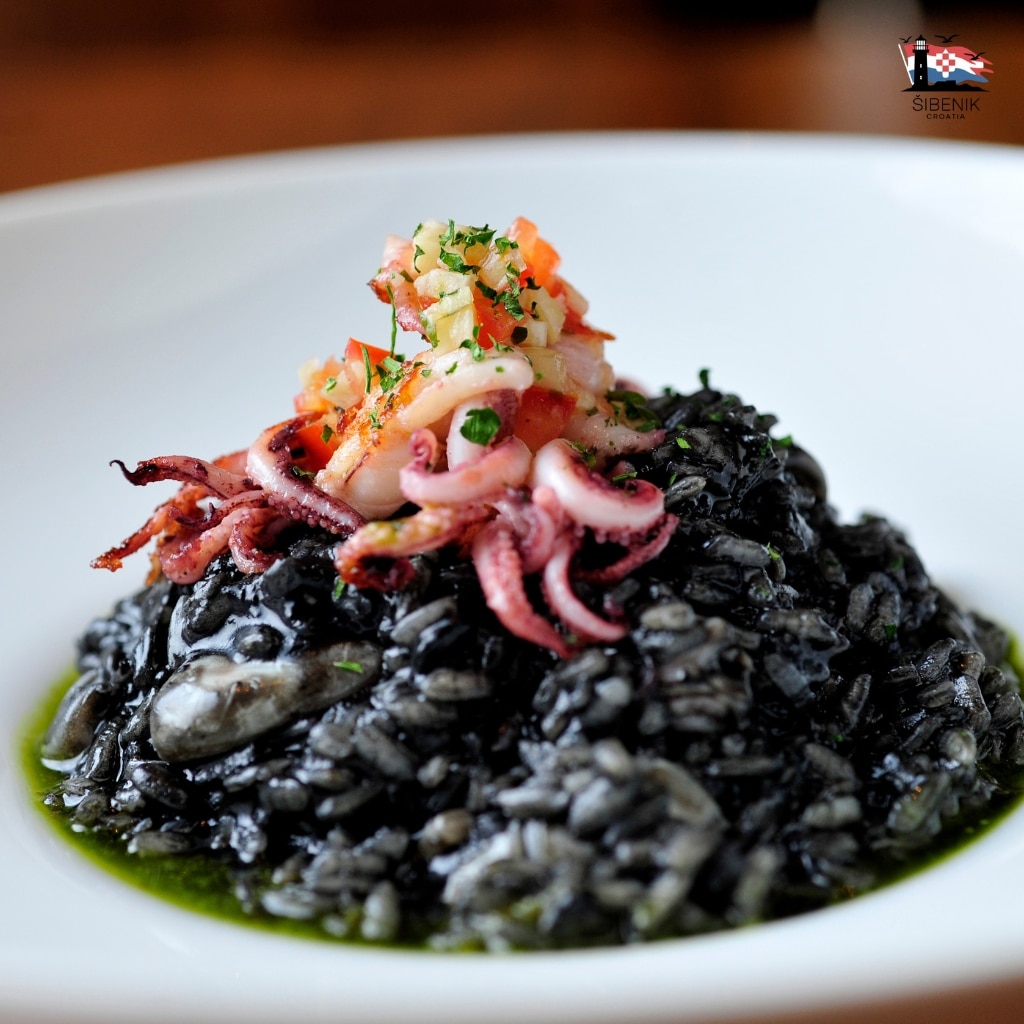If you dream of trying Šibenik cuisine, you’re in for a treat! This charming coastal town is full of local food specialties. Each dish is a story of history, flavor, and love for fresh ingredients.
When you visit Šibenik, trying its food is more than just eating. It’s an experience that connects you to the region’s heart. Get ready to explore the must-try dishes that will make your taste buds dance!
Key Takeaways
- Šibenik cuisine is rich in Mediterranean flavors.
- Locally sourced ingredients define traditional Croatian dishes.
- Sampling local food specialties enhances your travel experience.
- Each dish has historical significance in Šibenik’s culture.
- Dishes highlight the fresh seafood and meats of the region.
- Eating in Šibenik connects you with the local community.
Introduction to Šibenik Cuisine
Šibenik cuisine is a true reflection of Croatia’s flavors. It showcases a variety of dishes that highlight the region’s coastal beauty. The use of fresh seafood, herbs, and local vegetables is common, making each dish a taste of history and culture.
When you visit Šibenik, be sure to try its signature dishes. They are a mix of savory fish stews and tender meats with aromatic herbs. This combination creates a dining experience that is both memorable and satisfying.
Local Food Specialties: A Journey Through Tradition
Exploring Šibenik’s local food specialties reveals a world of flavors and textures. These dishes celebrate the region’s cultural heritage. Hearty meat dishes and fresh seafood from the Adriatic coast are common.
Visiting local restaurants and taverns lets you taste these authentic delicacies. Try dishes like peka and crni rizot for a memorable experience. Don’t miss out on delightful pastries, enjoyed during special occasions and family gatherings.
Dining in Šibenik is more than just eating; it’s about sharing stories and traditions. Each bite tells a story, deepening your understanding of local culture. Discovering these dishes makes your journey an adventure through Šibenik’s culinary heart.
Peka: The Heart of Šibenik’s Culinary Heritage

Peka is a traditional cooking method that’s very special in Croatian food culture. It uses a bell-shaped lid to cook ingredients, capturing their essence. This method requires patience and care, leading to dishes full of rich flavors.
Cooking Method of Peka
To make Peka, marinated meats, veggies, and sometimes rice go under the lid. Hot coals are placed on top, creating a slow-cooking oven. This way, the food becomes tender and juicy, full of flavor.
Popular Variations: Lamb, Veal, and Octopus
In Šibenik, Peka comes in many forms, showing the area’s diverse food scene. Lamb Peka is a hit, with its rich taste and herbs. Veal Peka offers a milder flavor that’s just as tasty.
For seafood fans, Octopus Peka is a must-try. It highlights the coastal area’s seafood, giving a unique taste. Each Peka dish brings a piece of Croatian heritage to your plate, making it a must-try in Šibenik.
Crni Rizot: The Iconic Black Risotto
Exploring Šibenik’s must-try dishes, Crni rizot, or black risotto, is a must. It’s a culinary gem that highlights the region’s seafood and bold flavors. The dish’s black color comes from squid ink, adding a burst of unforgettable flavor.
Ingredients and Preparation
Crni rizot’s preparation involves fresh ingredients. Key components include:
- Cuttlefish or squid
- Squid ink
- Garlic and onions
- White wine
- Risotto rice
- Olive oil and herbs
The cooking starts with sautéing garlic and onions in olive oil. Then, cuttlefish or squid is added. Next, risotto rice and white wine are introduced to enhance flavors.
Broth is added gradually, stirring until creamy. Squid ink is mixed in last, giving the risotto its dark color and briny taste.
Why It’s a Must-Try in Šibenik
Crni rizot is more than a meal; it’s a taste of the Adriatic Sea and local traditions. Its rich, briny flavor takes you to the heart of Šibenik’s fishing heritage. It’s perfect as a starter or main course, impressing everyone.
Locals and visitors alike see it as a must-try in Šibenik. It’s a key part of any culinary adventure in the area.
Ćevapi: Savory Grilled Meat Sausages

Exploring Šibenik’s food scene? You must try Ćevapi. These small, tasty sausages are made from minced beef or lamb. They’re seasoned with spices, shaped like fingers, and grilled to perfection.
They’re a key part of Croatian street food, served with fresh onions and warm flatbread. Ćevapi mix rich flavors with satisfying textures. They’re a hit with locals and visitors alike.
Enjoying Ćevapi is more than just eating. It’s a dive into Croatian food culture. Make sure to try them during your visit!
Dishes Celebrating the Adriatic: Seafood Delicacies
The Adriatic Sea is a treasure trove of seafood, making it key to Šibenik’s food scene. Mussels are a big hit, loved for their freshness and simple cooking. These dishes let you taste the sea’s essence right on your plate.
Mussels and Shellfish Dishes
Mussels are a favorite in Šibenik, often steamed with garlic, olive oil, and white wine. Clams and shrimp also make appearances, in dishes like risotto or with bread. They’re served with flavorful sauces that you’ll want to soak up.
Brodetto: The Traditional Fish Stew
Don’t miss out on Brodetto, a hearty fish stew that celebrates Šibenik’s sea heritage. It’s a mix of fish, tomatoes, onions, and herbs. Each bite is a taste of the Adriatic, showing off the coastal culture of Šibenik.
Pasticada: A Hearty Beef Dish
Pasticada is a beloved traditional Croatian beef dish. It brings rich flavors and warmth to the table. It comes from Dalmatia, showing the beauty of Croatian cooking and slow-cooking.
The dish uses marinated beef. It’s soaked in vinegar, pršut, garlic, and herbs. This makes it aromatic and savory.
Preparation and Flavor Profile
The key to Pasticada is its preparation. The beef marinates overnight, soaking up all the flavors. Then, it’s slow-cooked until tender.
This creates a delicious sauce. Serving it with gnocchi adds a nice texture. It makes every bite a flavorful meal.
Serving Suggestions
Pasticada is perfect for family gatherings or festive times. Serve it with creamy mashed potatoes or polenta for a feast. A robust red wine, like Plavac Mali, makes it even better.
Offering Pasticada is more than just food. It’s a way to share Dalmatian hospitality and warmth.
Fritule: Sweet Pastries for Every Celebration
Fritule are a favorite in Croatian pastries, loved in Šibenik. These small, sweet treats are key to festive times and holidays. They’re made with flour, eggs, sugar, and a hint of lemon zest for a refreshing touch.
The dough is shaped into small pieces and fried until golden. They’re light, airy, and sweet. A dusting of powdered sugar makes them even more appealing.
Fritule are more than just a dessert; they’re a tradition in Croatian dessert culture. They’re enjoyed at festive times and family gatherings. Trying fritule in Šibenik will add a sweet highlight to your visit.
Burek: Flaky Savory Pastry
Burek is a delightful flaky pastry that captivates taste buds with every bite. It’s often filled with minced meat or cheese. This makes it a satisfying choice for any meal.
The dough, expertly layered, is filled generously before being baked. It turns into a crispy golden-brown perfection.
You can find burek in bakeries and street food stalls throughout Šibenik. It’s a must-try for anyone exploring this charming city. This traditional Croatian street food is perfect for travelers who want to experience local flavors on the go.
The combination of a satisfying texture and hearty filling has made burek a beloved staple in Croatian cuisine. Don’t miss the chance to experience this delicious culinary treasure on your visit to Šibenik.
Dalmatian Platter: A Taste of Local Variety
The Dalmatian platter, also called “meza,” is a great way to try Croatian foods. It’s filled with many local dishes that show off the Dalmatian region’s food culture.
Components of the Platter
A typical Dalmatian platter has:
- Pršut: A dry-cured ham known for its rich taste and soft texture.
- Paški sir: A hard cheese made from sheep’s milk from the island of Pag. It has a special taste because of local herbs and salty air.
- Olives: Olives are served whole or as tapenade. They show the Mediterranean’s big influence on the area’s food.
- Grilled Sardines: These fish are seasoned with olive oil and herbs. They add a smoky flavor that goes well with the other foods.
This colorful mix is perfect for sharing. It’s great for parties with friends and family who love real food.
Ideal Pairings with Wine
Pairing the Dalmatian platter with local wines like Plavac Mali is a good idea. This red grape is common in the Dalmatian area. It’s known for:
- Its deep red color
- Its full-bodied taste
- Flavors of dark fruits, herbs, and spices
The strong tannins and balanced acidity of Plavac Mali go well with the savory pršut, tangy Paški sir, and smoky sardines. This makes it a favorite choice for those exploring Šibenik’s food scene.
Regional Influences on Šibenik Cuisine
Šibenik’s food is a mix of regional flavors and Croatian traditions. The city, by the Adriatic Sea, has fresh seafood. This is different from inland areas, where meat dishes are common.
Visitors will see how these influences change local tastes and ingredients. This makes each dish unique.
Many dishes use Mediterranean ingredients like olive oil and garlic. These are mixed with old cooking methods. This creates flavors that tell stories of the past.
Enjoying Šibenik’s food is like learning about its history. Knowing about these influences makes the food even more special.
Conclusion
Exploring traditional Šibenik food gives you a peek into Croatia’s rich culinary history. Each dish, like crni rizot and peka, shares its own story through taste and ingredients. This culinary journey shows the Adriatic coast’s best and connects you with local traditions.
Enjoying dishes like pasticada or seafood shows off Croatia’s vibrant flavors. Every meal is more than food; it’s about making memories and diving into local culture.
Whether you’re a seasoned traveler or new to exploring, trying traditional Šibenik food will make your trip better. It will also help you connect more deeply with this stunning region.
FAQ
What are the must-try dishes in Šibenik?
In Šibenik, you must try Peka, Crni Rizot, Ćevapi, Pasticada, and seafood dishes. Each dish brings a unique taste of the region’s culinary heritage.
What makes Šibenik’s cuisine unique?
Šibenik’s cuisine is special because it uses fresh, local ingredients. These come from the Adriatic Sea and inland areas. It reflects the region’s rich history and Mediterranean influences.
What is the main cooking technique used in Šibenik for traditional dishes?
Peka is a key cooking method in Šibenik. It cooks food under a bell-shaped lid with hot coals. This method makes meals tender and flavorful.
What is Crni Rizot and why is it special?
Crni Rizot, or black risotto, is a signature dish. It’s made with squid ink, giving it a unique flavor and color. It’s a must-try in Šibenik, showing the region’s love for seafood.
Where can I find authentic dishes in Šibenik?
Authentic Šibenik dishes are found at local restaurants and taverns. Exploring small eateries is the best way to experience local flavors.
What is Pasticada?
Pasticada is a traditional beef dish. It’s marinated in vinegar, pršut, garlic, and herbs, then slow-cooked. It’s served with gnocchi, making it a hearty meal.
Are there traditional pastries in Šibenik?
Yes! Fritule, small sweet pastries, are popular during festive occasions. They’re light, airy, and dusted with powdered sugar, capturing Croatian dessert traditions.
What is Burek?
Burek is a flaky pastry filled with savory minced meat or cheese. It’s widely available and perfect for a quick meal while exploring Šibenik.
What does the Dalmatian platter include?
The Dalmatian platter features local specialties like pršut, Paški sir, olives, and grilled sardines. It offers a flavorful introduction to the region’s cuisine.
How does geography influence Šibenik’s culinary offerings?
Šibenik’s location along the Adriatic Sea emphasizes seafood dishes. It also integrates inland traditions, focusing on hearty meats and rustic flavors. This creates a diverse culinary landscape.


